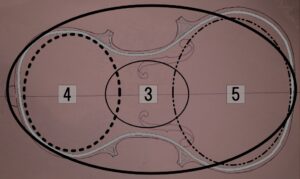Shape and sound of ancient musical instruments -part5
It was the discovery of Pythagoras that “musical tones have a simple integer ratio”. Is it something to do with it?
There are many other simple integer ratios.
1: 2: 3, 2: 3: 4, 3: 4: 5, 4: 5: 6 …
First, consider the one with the same top and bottom ratio.
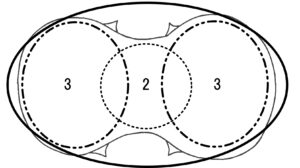
In this case, only two drums with the same eigen frequency mode are lined up, and the variation of eigen frequency cannot be increased, but the same vibration mode is strengthened. Brescia instruments are said to make a powerful sound.
Brescia’s instruments are close in size at the top and bottom, and traditional instruments are similar to this shape. However, it is expected that the timbre will be monotonous because there are few variations in the eigen frequency mode.
Next, let’s look at the ratio of 1: 1: 2.
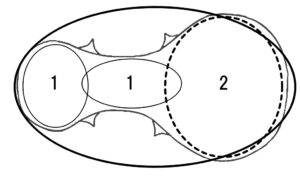
This is a large drum that is twice as large as a small drum. This also cannot increase the variation of the eigen frequency mode. Since an integer multiple of the eigen frequency mode is already included, the three ratios will increase the variation of the eigen frequency mode with a sequence of prime numbers other than 1. By the way, 3: 4: 5 is the same as 3: 2: 5. The simplest set of prime numbers.
Next, consider 4: 5: 6.
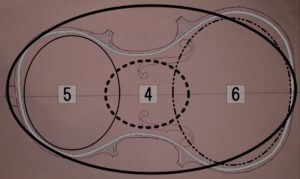
In other words, this is 2: 5: 3. The balance of appearance should be adjusted to a close ratio by multiplying it appropriately.
Thinking in this way, it seems that any triplet of prime numbers is possible, but is a simple integer ratio as good as a musical tone?
Stradivarius is said to have completed the violin instrument by fusing both the powerful Brescia timbre and the variety of Cremona timbres. In order to produce a variety of timbres, the ratio of triplets of prime numbers is required, and in order to produce a powerful sound, divided vibrations are not enough. It seems that such a thing is related to the problem of this ratio.
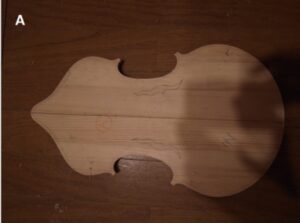
This is the instrument we will create. The outline (outer frame) is actually aligned with the sound (A). There is almost no difference in appearance, but (B) is the one in which the outline sounds are not aligned.
Can you see the difference?
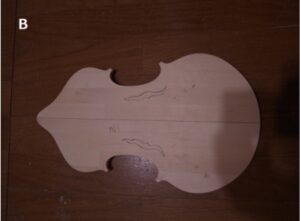
When we put (A) and (B) on top of each other, they differ by about 0.5 mm to 1.0 mm depending on the part of the outline. Let’s actually stack them.
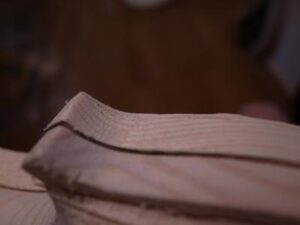
The larger one is (B). This is not enough to carve yet.
It’s a difference in size that we can hardly tell by appearance, but when you consider the sound information, such a slight difference makes a tremendous difference in timbre.
Let’s see how different the phonogram (A) and (B) are.
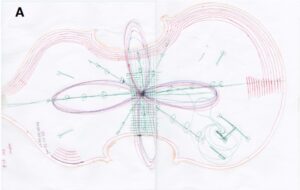
This is the phonogram of (A).
The isophonic lines drawn from the outside toward the center are actually tightly laid out toward the center. The square grid in the center also covers the entire surface.
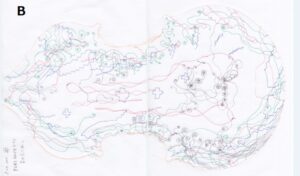
This is the phonogram of (B).
The figure of the sound is so different even though it looks almost the same. Interestingly, the one (B) that does not match the outline with the sound, makes a louder sound when rubbed with a finger, so it seems that this is a sounding instrument.
When I compared the sounds by rubbing them in a rougher state, where there were traces of sawing, I heard a louder sound.
There is an instrument that looks like an old violin with a notch on purpose, but it is presumed that it was intentionally finished to make it sound louder nearby, making it easier to sell.
This is a state where the sound is leaking, so even if it sounds, it will be limited to a specific range, and the sound will be loose as a whole.
(A) is a state in which a set of sounds is confined inside by building a sound barrier by the sound itself.
There is almost no difference in appearance between (A) and (B), but the phonogram shows that they are completely different things. Acoustically, the method of copying the appearance is completely nonsense. Even with a difference of 0.5 mm or less, the distance on the phonogram can be felt as many as a few meters. In acoustical problems, an error of a few millimeters can have a tremendous effect. It is possible to capture the phenomenon that occurs in this world with an error of several millimeters by using phonogram and control it. With just a few modifications, the overall nature can change drastically (a typical non-linear problem).
- カテゴリー
- BLOG

